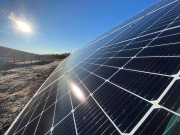Around the world, electricity system operators and commentators have noted that solar generation aligns well with peak demand, mainly because air conditioners draw a lot of power on hot sunny days when solar is producing the most. This has recently been shown in Colorado, California, and Australia, with earlier studies in many other jurisdictions.
This alignment between peak demand and solar power generation can mean smoother system operation and lower costs to produce and deliver energy. Meeting the peak demand and ensuring the infrastructure is sufficient for those few moments of time when the system requires just a bit more power comes at high cost. So, lowering the overall peak can mean major savings.
Alberta’s winter peak: An old-fashioned orthodoxy
While the benefits of solar abound, alignment with peak has not been among these because Alberta has historically been a “winter-peaking” jurisdiction. On our coldest, darkest night of the year — when everyone’s furnace fans and electric heaters are running as we huddle at home with the lights and the hockey game on, cooking meals and drying clothes and dishes — our electricity use peaks.
But this is changing. Air conditioning use is increasing in many Alberta communities. As we know, our seasons — including summers — are getting hotter and in some cases muggier. For example, parts of Calgary are seeing two to three times more heat wave days per year now than 60 years ago. We’re getting accustomed to controlling the temperatures in our offices, our workspaces and our homes. According to the Alberta Electric System Operator (AESO), this is increasing demand when it's hottest.
The new normal: regional summer peaks and faster summer peak growth
In recent years, we’ve seen regions of the province approach parity between summer and winter peak, developing essentially a “double-peaking system.” Comparing summer (2015) and winter (2015/2016) shows summer has overtaken winter maximum energy demand in three major regions.

The populous regions of Calgary and Edmonton, and the agriculture-intensive South region of the province, had a higher peak in summer than winter. Summer peak is also rising faster than winter peak, so it’s entirely possible Alberta will become a summer peaking province.
To accentuate this, generation supply is also challenged in hot weather because many fossil fuel power plants are less efficient at higher ambient temperatures. Moreover, heat puts additional strain on components of the transmission system that can lead to more failures. Combine higher demand with lower supply and grid failures and you have less reliable and more costly electricity when it's hottest.
Solar energy, just when and where we need it most
It’s almost too perfect to be true. Solar energy lines up amazingly well with our new summer-peaking regions.
It’s pretty intuitive. Because electrified cooling systems drive our peak summer demand, that demand aligns very well with hot, bright, power-giving sunshine. Solar energy will produce just when we need it.
It will also produce the most where we need it. The sunniest places in Alberta are the ones with the highest air conditioning use and agricultural/irrigation electricity demand in the summer.
But this goes even one step further. Solar is uniquely suitable to building rooftops. The three solar-peaking regions are where over 75 per cent of Alberta’s people live and work, with the very large number of homes, offices and workplaces. The South and Peace River valley include much of Alberta’s densest clustering of farm buildings — farmhouses, barns, Quonsets, etc.
This last point is particularly important because it is just these sorts of buildings that make Alberta’s electricity demand fluctuate. So, our residential and commercial buildings are just where you’d want to meet fluctuating demand peaks and avoid the need to build costly transmission lines to bring in electricity.
Solar will only get more beneficial
What does this mean for Alberta’s solar energy opportunity? For solar energy, this increasing alignment with both the timing and location of peak demand will:
- displace the most costly power in a system, which significantly lowers the overall price of electricity to consumers by lowering the price of all power at that time in the wholesale market.
- mitigate the need for new electricity system distribution and transmission infrastructure, which would otherwise have to be built to meet the growing peak demand and paid for by consumers
- avoid system losses by producing energy right where it’s needed
In short, it means solar will provide energy just when and where we need it most. And given clear trends, what solar offers will only become more and more important over time.













